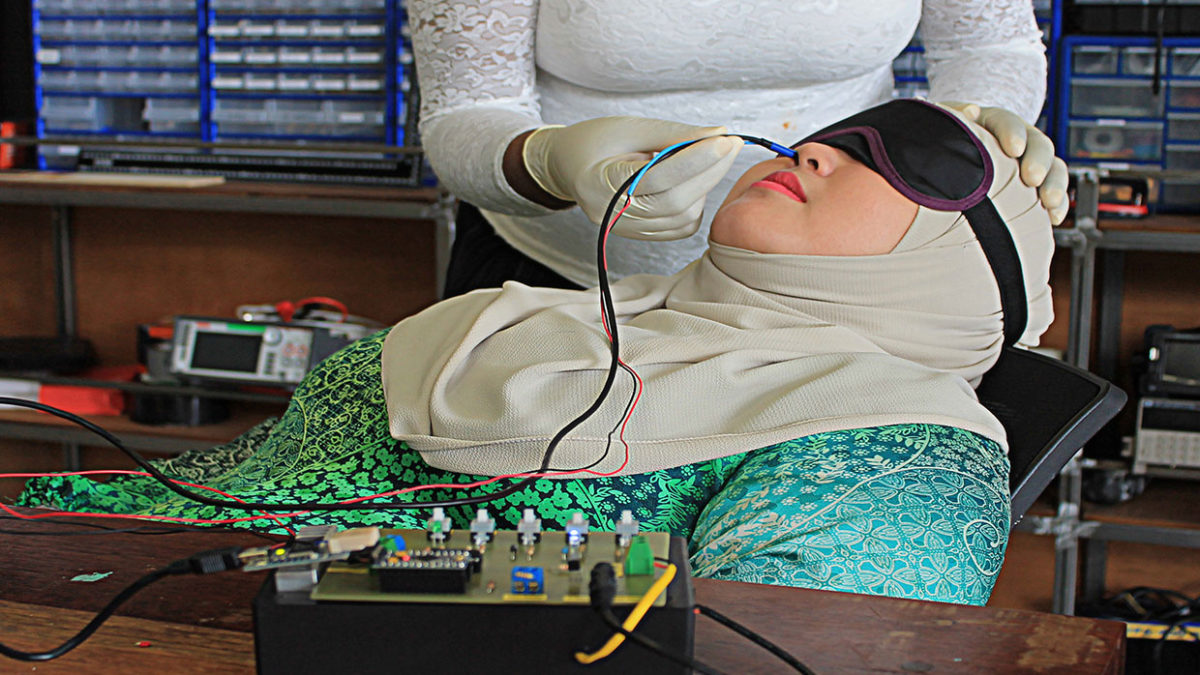Electrical stimulation of cells in the nasal passages produces sweet fragrances and chemical odors
Imagine a virtual reality movie about the Civil War where you can smell the smoke from the soldiers’ rifles. Or an online dating site where the profiles are scented with perfume or cologne. Or an augmented reality app that lets you point your phone at a restaurant menu and sample the aroma of each dish.
The researchers who are working on “digital smell” are still a very long way from such applications—in part because their technology’s form factor leaves something to be desired. Right now, catching a whiff of the future means sticking a cable up your nose, so electrodes can make contact with neurons deep in the nasal passages. But they’ve got some ideas for improvements.
This digital smell research is led by Kasun Karunanayaka, a senior research fellow at the Imagineering Institute in Malaysia. He started the project as a Ph.D. student with Adrian Cheok, now director of the institute and a professor at the City University of London, who’s on a quest to create a “multisensory Internet.” In one of Cheok’s earliest projects he sent hugs to chickens, and his students have also worked with digital kisses and electric taste.
Karunanayaka says most prior experiments with digital smell have involved chemical cartridges in devices that attach to computers or phones; sending a command to the device triggers the release of substances, which mix together to produce an odor.
Working in that chemical realm, Karunanayaka’s team is collaborating with a Japanese startup called Scentee that he says is developing “the world’s first smartphone gadget that can produce smell sensations.” They’re working together on a Scentee app that integrates with other apps to add smells to various smartphone functions. For example, the app could link to your morning alarm to get the day started with the smell of coffee, or could add fragrances to texts so that messages from different friends come with distinct aromas.
But Karunanayaka’s team wanted to find an alternative to chemical devices with cartridges that require refilling. They wanted to send smells with electricity alone.
For his experiments, he convinced 31 volunteers to let him stick a thin and flexible cable up their noses. The cable was tipped with both a tiny camera and silver electrodes at its tip. The camera helped researchers navigate the nasal passages, enabling them to bring the electrodes into contact with olfactory epithelium cells that lie about 7 centimeters above and behind the nostrils. These cells send information up the olfactory nerve to the brain.
Typically, these olfactory cells are stimulated by chemical compounds that bind to cell receptors. Instead, Karunanayaka’s team zapped them with an electric current.

The researchers had previously combed the scientific literature [PDF] for examples of electrical stimulation of nasal cells, and found some reports that the stimulation caused test subjects to perceive odors. So they decided to experiment with different parameters of stimulation, altering both the amount and frequency of the current, until they found the settings that most reliably produced smell sensations.
The subjects most often perceived odors they described as fragrant or chemical. Some people also reported smells that they described as fruity, sweet, toasted minty, or woody.
This experiment was a very basic proof-of-concept, Karunanayaka says. The next step is to determine whether certain stimulation parameters are reliably linked to certain smells. He must also investigate how much variability there is between subjects. “There may be differences due to age, gender, and human anatomy,” he says.
The biggest question, however, is whether he can find a way to produce these ghostly aromas without sticking a tube up people’s noses. The experiments were very uncomfortable for most of the volunteers, Karunanayaka admits: “A lot of people wanted to participate, but after one trial they left, because they couldn’t bear it.”

Two possible solutions suggest themselves, Karunanayaka says: They could make the insert smaller, more flexible, and less unbearable. Or they could skip past the nose’s olfactory cells and directly stimulate the brain.
As a step toward that neurotech goal, the Imagineering Institute researchers are planning a brain-scanning collaboration with Thomas Hummel, a leading expert in smell disorders at the Technische Universität Dresden in Germany. In the planned experiment, volunteers will both smell real odiferous objects, such as a rose, and also receive nasal stimulation. All these sniffs will take place while the volunteers are getting their brains scanned by a noninvasive method such as fMRI.
“We’ll see which areas in the brain are activated in each condition, and then compare the two patterns of activity,” Karunanayaka says. “Are they activating the same areas of the brain?” If so, that brain region could become the target for future research. Maybe the researchers could use a headset that provides a noninvasive form of stimulation to trigger that brain region, thus producing smell sensations without the need for either a rose or a nose-cable.
Such tech could serve a restorative purpose: People with smell disorders could theoretically wear some headgear to regain some smell functions. And for people with intact sniffer systems, it could provide enhancements: For example, VR headset makers could build in the brain-stimulating tech to provide users with a more immersive and richer sensory experience.

